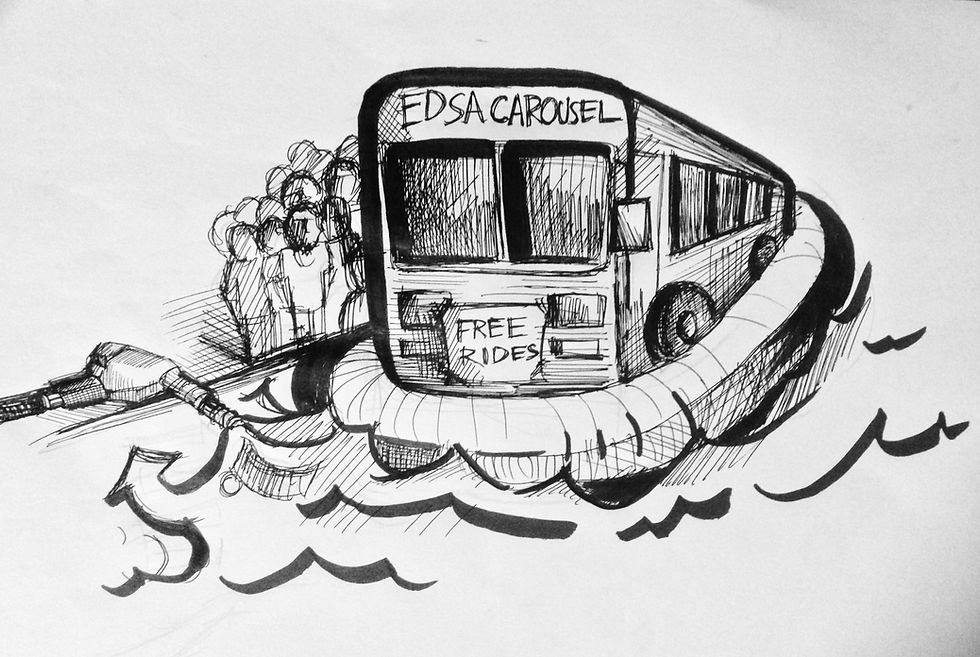Free Carousel Bus rides, Beneficial or Brutal?
- Christian Pataray
- Jul 14, 2022
- 3 min read

April 2022, the national government reimplemented Service Contracting under the General Appropriations of 2022, a program that gives free rides to commuters along the EDSA Carousel route. The program went smoothly for the first few weeks, commuters saved some cash, and the drivers got their wages, although long, lines flow smoothly in terminals and the same goes in stops. The billion-peso question for this program is: Is it sustainable? Did it solve any long-time problems in the transportation sector of the area? Was the program just a short-term solution?
After a few months of the program, issues and problems arose. People started to weigh in on their unforeseen costs when going up in line for the free ride, they realized that they were sacrificing their time and energy to save money. Some bus drivers expressed their dissatisfaction with their delayed wages in the program. The Commission on Audit found that the LTFRB utilized P59.7 million of its P5.58 billion budget for the program in 2020, less than 2% of the allocated funds. Under LTFRB Memorandum Circular 2021-029, 30% of the funding for the service contracting program is for drivers and conductors.
On June 30, 2022, the administration changed. The new president approved the memorandum granting an extension for the ‘Libreng Sakay’ until December of the current year. But the problem is, that the leaving administration has already distributed 93.2% of its budget to the departments, leaving the Marcos Jr. administration a measly 343.9 billion pesos to manage for the entire year. According to the LTFRB, they are spending at least 10 million pesos per day on the Libreng Sakay program, take note that the program is implemented nationwide, not only in Metro Manila. Doing the math, we can easily deduce that P343 billion is more than enough to support the extension of the Libreng Sakay, but let’s not forget that we have other programs that are ongoing and in need of funds. With this amount of funds, we can have a decent, safe, and comfortable street for all kinds of transportation that enhance the city's sustainability by encouraging active transportation, effective resource use, and the use of practices that protect air and water quality. But instead, we always resort to superficial and short-term patch that doesn’t really solve the problem.
Benefits of the Libreng Sakay program? The commuters saved a lot of money because of the free rides. The program services over 129,000 commuters daily, and every commuter saves a significant amount of cash from the program but at the cost of compromising their time. What are its long-term effects? Spending 10 million pesos per day is a hefty amount of money, in my opinion, the government might go over the budget and spend more than what they expect due to the rising gas prices and inflation rate, as we all know, going over budget means another loan for the country. Not to mention that since these rides are free amid oil prices and transportation price hikes, commuters would be rabid, of course, to get their part of the law. As a result, travels that usually take 30 minutes to 1 hour, now extend to two to four hours—take note that this is just the waiting time on an average basis. Imagine the activities and opportunities that you can do in those two to four hours of yours every day instead of falling in line to go home or go to work.
In conclusion, the whole program is just a short-term suspension to counter the problems that arose during the pandemic. Filipinos are, in fact, aware and willing to walk and use bicycles as a form of transportation. If only we have better roads that are actually friendly to the people and not to the vehicles. We can enjoy the free rides as a commuter until it lasts but never forget that we are yet to feel the effects of this decision until a few years later.




Comments